Why Should You Write Shorter (But Better) Content?
 How long should your content be? As long as it needs to be, but no longer.
The content length debate has proved long, circuitous and at times rancorous. Even more often, however, the discussion tends to either miss the point entirely or focus on the wrong areas of measurement, typically veering off course to focus on incomplete or incorrect data.
The length of your online content should initially be determined by the needs of the audience members you expect to consume the information.
With this post, I hope to definitively make the case, through anecdotal evidence, personal experience, and data, that the strength of your message is more important than the length of your content. Also, once you’re clear on the audience and their intent, creating shorter but better content will become the norm.
How long should your content be? As long as it needs to be, but no longer.
The content length debate has proved long, circuitous and at times rancorous. Even more often, however, the discussion tends to either miss the point entirely or focus on the wrong areas of measurement, typically veering off course to focus on incomplete or incorrect data.
The length of your online content should initially be determined by the needs of the audience members you expect to consume the information.
With this post, I hope to definitively make the case, through anecdotal evidence, personal experience, and data, that the strength of your message is more important than the length of your content. Also, once you’re clear on the audience and their intent, creating shorter but better content will become the norm.
Why Should You Write Shorter (But Better) Content? via @RonellSmith @CoSchedule
Click To TweetFree Content + Calendar Templates From CoSchedule
Craft content and schedule deadlines with ease using this pair of free templates.How I Came to Believe Shorter Content is Better Content
In college, I would read whole sections of books, on topics ranging from biology to history to physics. Crazy as it sounds, I would check out and read every single book on a given topic, and when I was done, I’d move to the next topic. My reading list was as long as the rap sheet for a career criminal. After graduating college and beginning my career, I often read 10 to 12 hours per day on weekends, as I stayed at local independent bookstores from open to close. But as I gained more and more responsibilities at home and at work, I had to make some tough choices about what I read. During this time I developed what I called the three “I’s” of content success to help streamline what I made time to read:- Immediacy: I need to walk away with at least three takeaways I can put to immediate use.
- Inspiration: I should be eager to apply what I’ve learned to benefit my career or my personal life in some meaningful way.
- Indispensability: Were I to refrain from consuming this information, I would regret it at some later point.
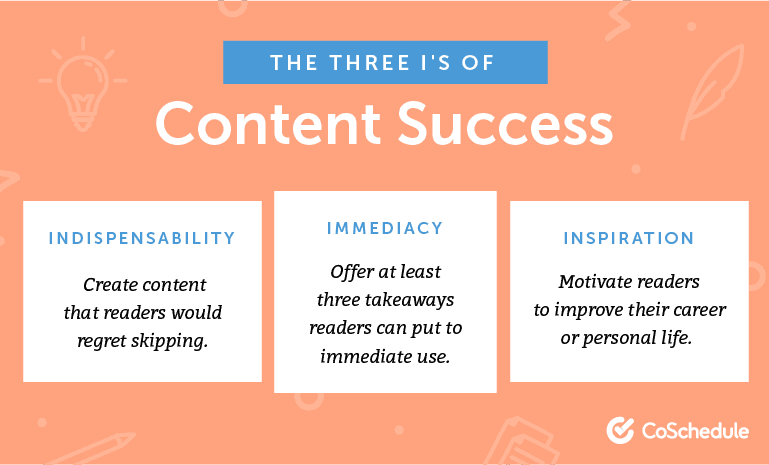 I reasoned that other busy professionals were likely employing similar calculus.
I reasoned that other busy professionals were likely employing similar calculus.
“[Primarily, people care about content length] because they’re making a judgment call of your content’s value against their available time,” says web copywriter Klettke.
 In the years that followed, as I began helping brands design, create and share content online, I saw how myriad brands were missing the boat, focusing on their needs—keywords—which led to the creation of millions of thin, poorly written posts meant to game the system and earn rank without much effort.
But that thanks to Google’s Panda search filter, these pages were effectively neutralized.
Brands, after having their hands slapped by Google, then went in the opposite direction, creating almost exclusively lengthier posts, which could more easily hide the inclusion of dozens of keyword strings.
You can guess what then happened: Brands noticed a higher percentage of longer posts dominating the search engine results pages (SERPs). From there, it became a self-fulfilling prophecy—they created more and more longer posts; more and more longer posts dominated the top organic results.
We missed the forest for the trees.
In the years that followed, as I began helping brands design, create and share content online, I saw how myriad brands were missing the boat, focusing on their needs—keywords—which led to the creation of millions of thin, poorly written posts meant to game the system and earn rank without much effort.
But that thanks to Google’s Panda search filter, these pages were effectively neutralized.
Brands, after having their hands slapped by Google, then went in the opposite direction, creating almost exclusively lengthier posts, which could more easily hide the inclusion of dozens of keyword strings.
You can guess what then happened: Brands noticed a higher percentage of longer posts dominating the search engine results pages (SERPs). From there, it became a self-fulfilling prophecy—they created more and more longer posts; more and more longer posts dominated the top organic results.
We missed the forest for the trees.
Misreading the tea leaves regarding how long your website content should be
For nearly a decade now, it’s been taken as gospel that longer posts are better for your brand. After all, we have data to prove as much. Or so it seemed. In 2009, for example, Moz shared an article that highlighted blog posts 1,800 words or longer as ideal for links.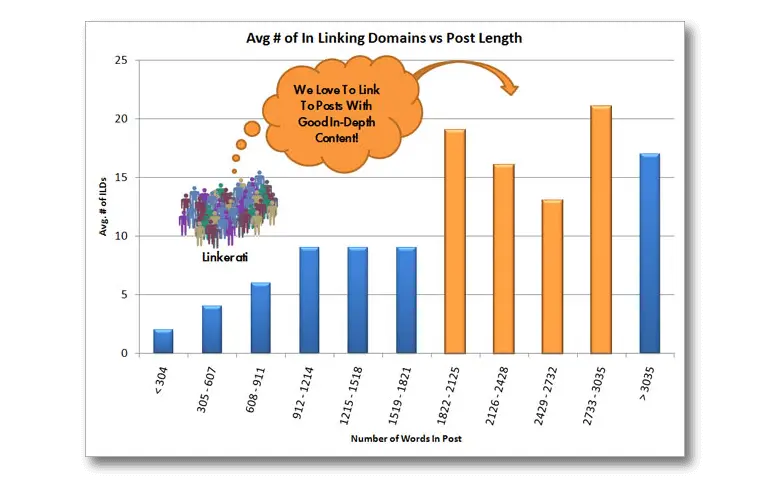 Image Source: https://moz.com/blog/what-makes-a-link-worthy-post-part-1
In 2013, Medium fired the shot that seemingly sent everyone to create 5,000-word blog posts, when they published The Optimal Post is 7 Minutes.
Image Source: https://moz.com/blog/what-makes-a-link-worthy-post-part-1
In 2013, Medium fired the shot that seemingly sent everyone to create 5,000-word blog posts, when they published The Optimal Post is 7 Minutes.
 Image Source: https://medium.com/data-lab/the-optimal-post-is-7-minutes-74b9f41509b
And, then, In 2015, a study conducted by BuzzSumo and Moz seemed to definitely show that longer content was the only way to go if shares and links were the goal.
Image Source: https://medium.com/data-lab/the-optimal-post-is-7-minutes-74b9f41509b
And, then, In 2015, a study conducted by BuzzSumo and Moz seemed to definitely show that longer content was the only way to go if shares and links were the goal.
 Image Source: https://moz.com/blog/content-shares-and-links-insights-from-analyzing-1-million-articles
It’s easy to see how, where and why the steady march of long content began.
But what everyone seemed to miss, in these studies and numerous others, were the footnotes that seemed to tell a fuller, richer more nuanced story.
For example, while many people seemed to take for granted that the Medium study suggested long-form content as the way to go, simple math reveals a different truth.
The average person reads 250 words per minute. 250 words times seven minutes is about 1,700 words. Not short, but certainly not as long as most of the content many brands now create. However—and most important—most web visitors will spend 10 seconds or so on your site/page.
Wrote the author of the Medium study:
Image Source: https://moz.com/blog/content-shares-and-links-insights-from-analyzing-1-million-articles
It’s easy to see how, where and why the steady march of long content began.
But what everyone seemed to miss, in these studies and numerous others, were the footnotes that seemed to tell a fuller, richer more nuanced story.
For example, while many people seemed to take for granted that the Medium study suggested long-form content as the way to go, simple math reveals a different truth.
The average person reads 250 words per minute. 250 words times seven minutes is about 1,700 words. Not short, but certainly not as long as most of the content many brands now create. However—and most important—most web visitors will spend 10 seconds or so on your site/page.
Wrote the author of the Medium study:
“Great posts perform well regardless of length, and bad posts certainly don’t get better when you stretch them out.”The head of BuzzSumo, Steve Rayson, corroborates my earlier point, that long form content does well in large part because so much short form content is so poorly written.
“The average shares for long form content are only higher because there is so much poor quality short form content, and this drags the average for short form content down,” says Rayson. “Inherently long form is not better, in fact many of us prefer the author to take time to make content shorter. I did an analysis of the posts of the top 100 Mar/Tech blogs and 81 of the 100 most shared posts had less than 1,000 words. Short form can be very powerful.”

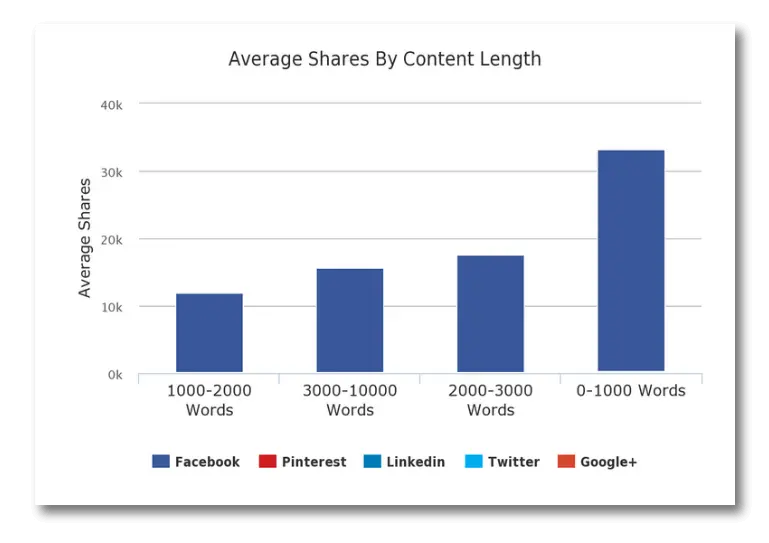 Image Source: http://buzzsumo.com/blog/how-ifl-science-is-nailing-it-with-short-form-viral-content/
Rayson cites IFLScience as a brand who consistently shares short-form content that does exceedingly well.
The brand isn’t simply doing well on social, however. This graph below from SimilarWeb tells a more complete story.
Image Source: http://buzzsumo.com/blog/how-ifl-science-is-nailing-it-with-short-form-viral-content/
Rayson cites IFLScience as a brand who consistently shares short-form content that does exceedingly well.
The brand isn’t simply doing well on social, however. This graph below from SimilarWeb tells a more complete story.
 Not too shabby for a brand whose content is mostly under 1,000 words.
Even better, they aren’t doing anything your brand couldn’t execute. In fact, their content follows a clear script:
Not too shabby for a brand whose content is mostly under 1,000 words.
Even better, they aren’t doing anything your brand couldn’t execute. In fact, their content follows a clear script:
- Imminently shareable (e.g., novel, counter-intuitive, entertaining, educational, informative, newsy, etc.)
- Focused on a single topic
- Contains an amazing graphic/visual
- Featured an enticing headline
How to Adopt a Shorter Content Mindset For Your Brand
Now that we know creating longer content, which can be more time consuming and is not ideal for most brands, especially small, resource-challenged brands, is far from a panacea for attaining your goals, what should you do to acquire shares and links, and increase read times? Let’s break it down by social sharing and on-site content.#1: Social Media Content
Even if your brand doesn’t have a huge following on social media, sharing your content via social media should be an important component of your brand’s content strategy. Why? Social media can help you attain and grow an audience and help your brand distribute its content. Plus, as the IFLScience example makes clear, success via social sharing is within your grasp:- Test headlines: There are numerous headline formulas available on the web; the only headline ‘formula’ I want you to remember, though, is test, test, test. Try long headlines, short headlines, include numbers, “how to,” “tips,” and questions.
- Include graphics: Don’t share a social media post without an image. That. Is. All.
- Keep it simple: Don’t overthink it. Be explicit is stating the point and getting out of the readers way.
#2: Blog Content
A word we in SEO and content marketing circles hear thrown around a lot is intent. That is, what’s the intent of the web searcher behind a certain query. It’s no trivial matter. Consider, for example, that at least three entities/parties have a vested interest in parsing intent as early as possible:- Search engines, so they can deliver the best result
- Brands, so they can be the best result
- Web searchers, who hope to quickly find the best result
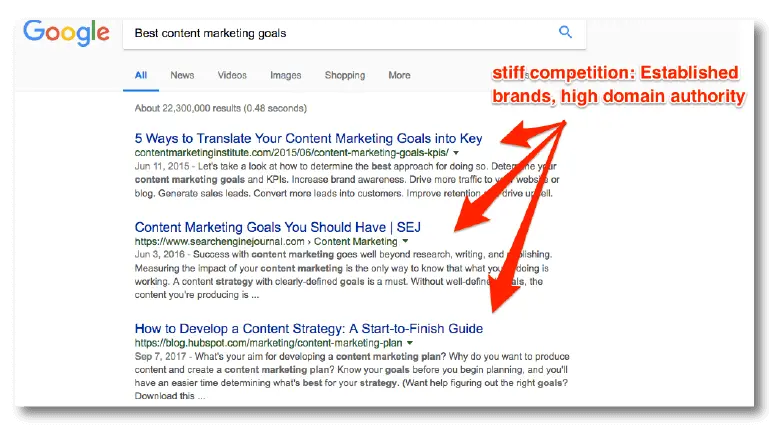 Right away you can see that the top of the SERPs is dominated by big, powerful brands.
Most important, you also see how Google views this query since it’s returning information aimed at helping brands determine what their goals should be, in addition to outlining elements of content strategy, content planning and content marketing strategy.
Right away, you can see that a piece of content that expects to rank well had better include elements regarding the following:
Right away you can see that the top of the SERPs is dominated by big, powerful brands.
Most important, you also see how Google views this query since it’s returning information aimed at helping brands determine what their goals should be, in addition to outlining elements of content strategy, content planning and content marketing strategy.
Right away, you can see that a piece of content that expects to rank well had better include elements regarding the following:
- Content planning,
- Content goals,
- Content marketing goals,
- Content strategy,
- Content marketing strategy, and other variants of the aforementioned keywords/keyword phrases.
- Include the most important keywords within the first sentence of the blog post
- Use two or three other keyword variants (naturally) within the first paragraph of the post
- Attempt to answer the most relevant questions a web searcher would have with the rest of the text
“It’s no longer as simple as honing the keyword relevance of one page and getting some links,” says SEO expert Eric Enge. “Those things still matter, but a deeper understanding of relevance is needed to succeed in today’s search environment, and this should impact what keywords you attempt to rank for.”
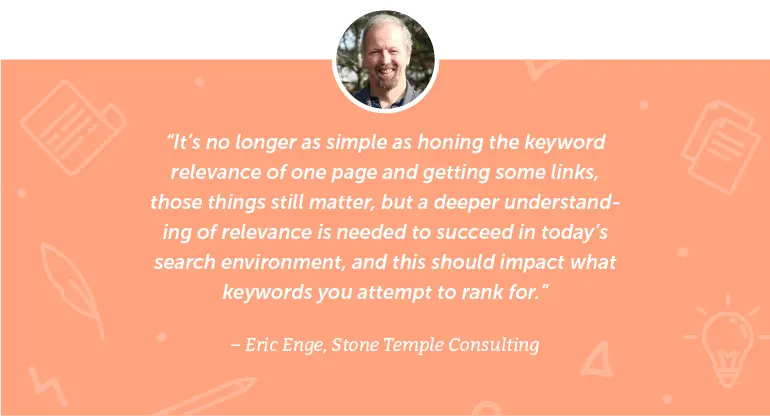 The same logic can be applied to any content your brand creates.
Some simple guidelines I use to help brands manage the process include, but are not limited to:
The same logic can be applied to any content your brand creates.
Some simple guidelines I use to help brands manage the process include, but are not limited to:
- Blog posts: Consider making long blog posts into series of shorter blog posts. This way, you increase readership, time on site, searcher satisfaction and can likely include keywords in a more natural fashion.
- Case studies and In-depth guides: Instead of copying the length and style of the competitors’ case studies, consider how you can distill the information in a more succinct, easy-to-consume fashion. That is, don’t make the starting point what the competition is doing. Instead, reset the starting point by thinking “How can I share best-in-class information on this topic?”
- Videos & podcasts: Rather than thinking about how long a podcast or video should be, enter into interaction with specific questions you’d like answered, which prevents rambling and more easily increases the likelihood that viewers and listeners will fully listen to and consume the broadcast.
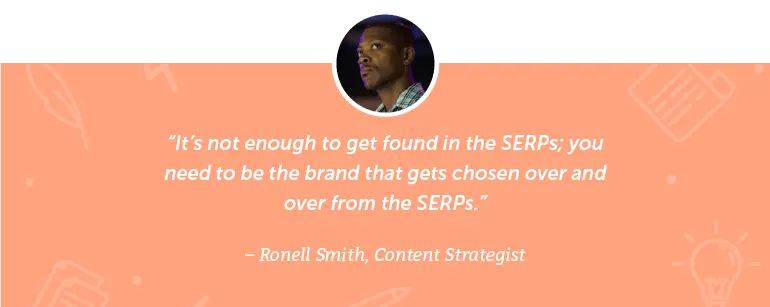
Summary
“How long should your content be?” is the wrong question. Instead ask, what would a reader expect to learn, and how can I exceed their expectation?”“Content should be long enough to be helpful, meet marketing goals, and provide a unique take…and no longer,” says Stone Temple Consulting’s Mark Traphagen.I concur. Wholeheartedly. If you're interested in becoming a better writer of short, punchy content, I highly recommend How to Write Short: Word Craft for Fast Times, by Roy Peter Clark and Ann Handley's Everybody Writes: Your Go-to Guide to Creating Ridiculously Good Content


